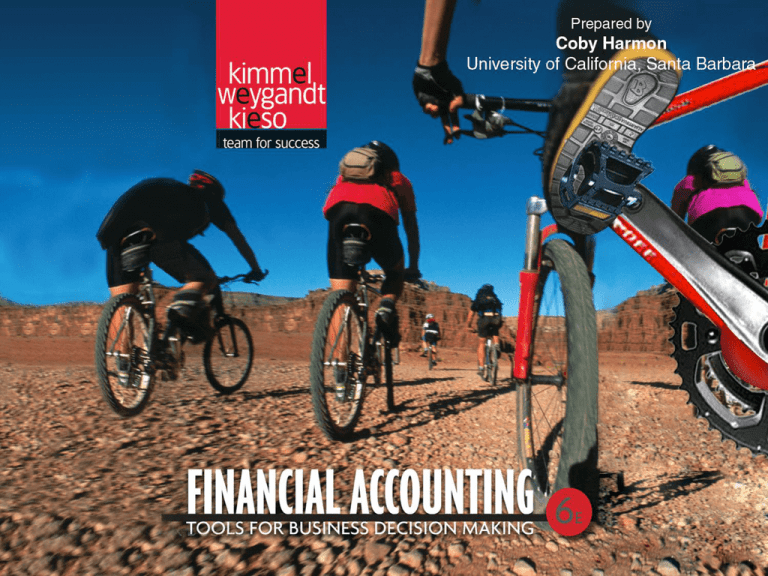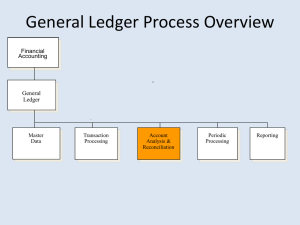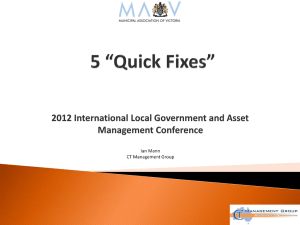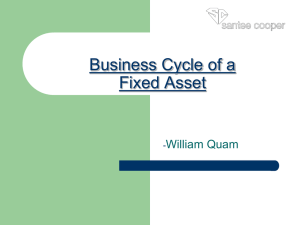
Chapter
9-1
9
REPORTING
AND ANALYZING
LONG-LIVED ASSETS
Chapter
9-2
Financial Accounting, Sixth Edition
Study Objectives
1.
Describe how the cost principle applies to plant assets.
2.
Explain the concept of depreciation.
3.
Compute periodic depreciation using the straight-line method, and
contrast its expense pattern with those of other methods.
4.
Describe the procedure for revising periodic depreciation.
5.
Explain how to account for the disposal of plant assets.
6.
Describe methods for evaluating the use of plant assets.
7.
Identify the basic issues related to reporting intangible assets.
8.
Indicate how long-lived assets are reported in the financial
statements.
Chapter
9-3
Reporting and Analyzing Long-Lived Assets
Plant Assets
Chapter
9-4
Intangible Assets
Determining the cost of
plant assets
Accounting for
intangibles assets
Accounting for plant
assets
Types of intangibles
assets
Analyzing plant assets
Financial statement
presentation of long-lived
assets
Plant Assets
Section One
Plant assets are resources that have
physical substance (a definite size and shape),
are used in the operations of a business,
are not intended for sale to customers,
are expected to provide service to the company for a
number of years, except for land.
Referred to as property, plant, and equipment; plant and
equipment; and fixed assets.
Chapter
9-5
Plant Assets
Section One
Plant assets are critical to a company’s success
Illustration 9-1
Chapter
9-6
Determining the Cost of Plant Assets
Cost Principle - requires that companies record plant
assets at cost.
Cost consists of all expenditures necessary to
acquire an asset and make it ready for its intended use.
Revenue expenditure – costs incurred to acquire a plant
asset that are expensed immediately.
Capital expenditures - costs included in a plant asset
account.
Chapter
9-7
SO 1 Describe how the cost principle applies to plant assets.
Determining the Cost of Plant Assets
Cost - cash paid in a cash transaction or the cash
equivalent price paid.
Cash equivalent price is the
fair value of the asset given up or
fair value of the asset received,
whichever is more clearly determinable.
Chapter
9-8
SO 1 Describe how the cost principle applies to plant assets.
Determining the Cost of Plant Assets
Land
All necessary costs incurred in making land ready for its
intended use increase (debit) the Land account.
Costs typically include:
1) cash purchase price,
2) closing costs such as title and attorney’s fees,
3) real estate brokers’ commissions, and
4) accrued property taxes and other liens on the land
assumed by the purchaser.
Chapter
9-9
SO 1 Describe how the cost principle applies to plant assets.
Determining the Cost of Plant Assets
Illustration: Assume that Hayes Manufacturing Company
acquires real estate at a cash cost of $100,000. The property
contains an old warehouse that is razed at a net cost of $6,000
($7,500 in costs less $1,500 proceeds from salvaged materials).
Additional expenditures are the attorney’s fee, $1,000, and the
real estate broker’s commission, $8,000.
Required: Determine the amount to be reported as the cost of
the land.
Chapter
9-10
SO 1 Describe how the cost principle applies to plant assets.
Determining the Cost of Plant Assets
Required: Determine amount to be reported as the cost of the
land.
Land
Cash price of property ($100,000)
$100,000
Net removal cost of warehouse ($6,000)
6,000
Attorney's fees ($1,000)
1,000
Real estate broker’s commission ($8,000)
8,000
Cost of Land
Chapter
9-11
$115,000
SO 1 Describe how the cost principle applies to plant assets.
Determining the Cost of Plant Assets
Land Improvements
Includes all expenditures necessary to make the
improvements ready for their intended use.
Examples: driveways, parking lots, fences, landscaping,
and underground sprinklers.
Limited useful lives.
Expense (depreciate) the cost of land improvements over
their useful lives.
Chapter
9-12
SO 1 Describe how the cost principle applies to plant assets.
Determining the Cost of Plant Assets
Buildings
Includes all costs related directly to purchase or construction.
Purchase costs:
Purchase price, closing costs (attorney’s fees, title insurance,
etc.) and real estate broker’s commission.
Remodeling and replacing or repairing the roof, floors,
electrical wiring, and plumbing.
Construction costs:
Chapter
9-13
Contract price plus payments for architects’ fees, building
permits, and excavation costs.
SO 1 Describe how the cost principle applies to plant assets.
Determining the Cost of Plant Assets
Equipment
Include all costs incurred in acquiring the equipment and
preparing it for use.
Costs typically include:
Chapter
9-14
Cash purchase price.
Sales taxes.
Freight charges.
Insurance during transit paid by the purchaser.
Expenditures required in assembling, installing, and testing
the unit.
SO 1 Describe how the cost principle applies to plant assets.
Determining the Cost of Plant Assets
Illustration: Lenard Company purchases a delivery truck at a
cash price of $22,000. Related expenditures are sales taxes
$1,320, painting and lettering $500, motor vehicle license $80,
and a three-year accident insurance policy $1,600. Compute
the cost of the delivery truck.
Truck
Cash price
$22,000
Sales taxes
1,320
Painting and lettering
Cost of Delivery Truck
Chapter
9-15
500
$23,820
SO 1 Describe how the cost principle applies to plant assets.
Determining the Cost of Plant Assets
Illustration: Lenard Company purchases a delivery truck at a
cash price of $22,000. Related expenditures are sales taxes
$1,320, painting and lettering $500, motor vehicle license $80,
and a three-year accident insurance policy $1,600. Prepare the
journal entry to record these costs.
Equipment
23,820
License expense
Prepaid insurance
Cash
Chapter
9-16
80
1,600
25,500
SO 1 Describe how the cost principle applies to plant assets.
Determining the Cost of Plant Assets
To Buy or Lease?
A lease is a contractual agreement in which the owner of an
asset (lessor) allows another party (lessee) to use the asset
for a period of time at an agreed price.
Some advantages of leasing
1. Reduced risk of obsolescence.
2. Little or no down payment.
3. Shared tax advantages.
4. Assets and liabilities not reported.
Capital lease - lessees show the asset and liability on the balance sheet.
Chapter
9-17
SO 1 Describe how the cost principle applies to plant assets.
Chapter
9-18
Accounting for Plant Assets
Depreciation
Process of allocating to expense the cost of a plant asset
over its useful (service) life in a rational and systematic
manner.
Process of cost allocation, not asset valuation.
Applies to land improvements, buildings, and equipment,
not land.
Depreciable, because the revenue-producing ability of
asset will decline over the asset’s useful life.
Chapter
9-19
SO 2 Explain the concept of depreciation.
Accounting for Plant Assets
Factors in Computing Depreciation
Illustration 9-6
Cost
Chapter
9-20
Useful Life
Salvage Value
SO 2 Explain the concept of depreciation.
Accounting for Plant Assets
Depreciation Methods
Management selects the method it believes best measures
an asset’s contribution to revenue over its useful life.
Examples include:
(1) Straight-line method.
(2) Declining-balance method.
(3) Units-of-activity method.
Illustration 9-7
Use of depreciation
methods in major
U.S. companies
Chapter
9-21
SO 3
Accounting for Plant Assets
Illustration: Bill’s Pizzas purchased a small delivery truck on
January 1, 2012.
Required: Compute depreciation using the following.
(a) Straight-Line. (b) Units-of-Activity. (c) Declining Balance.
Chapter
9-22
SO 3 Compute periodic depreciation using the straight-line method,
and contrast its expense pattern with those of other methods.
Accounting for Plant Assets
Straight-Line
Expense is same amount for each year.
Depreciable cost = Cost less salvage value.
Illustration 9-8
Chapter
9-23
SO 3 Compute periodic depreciation using the straight-line method,
and contrast its expense pattern with those of other methods.
Accounting for Plant Assets
Illustration: (Straight-Line Method)
Illustration 9-9
Year
Depreciable
Cost
2012
$ 12,000
2013
12,000
20
2,400
4,800
8,200
2014
12,000
20
2,400
7,200
5,800
2015
12,000
20
2,400
9,600
3,400
2016
12,000
20
2,400
12,000
1,000
2012
Journal
Entry
Chapter
9-24
x
Rate
=
20%
Annual
Expense
Accum.
Deprec.
Book
Value
$ 2,400
$ 2,400
$ 10,600
Depreciation expense
Accumulated depreciation
2,400
2,400
SO 3 Compute periodic depreciation using the straight-line method,
and contrast its expense pattern with those of other methods.
Partial
Year
Accounting for Plant Assets
Illustration: (Straight-Line Method)
Assume the delivery truck was purchased on April 1, 2010.
Year
2012
$ 12,000
x
20% =
$ 2,400
2013
12,000
x
20% =
2014
12,000
x
2015
12,000
2016
2017
Rate
Partial
Year
Annual
Expense
Depreciable
Cost
Current
Year
Expense
Accum.
Deprec.
1,800
$ 1,800
2,400
2,400
4,200
20% =
2,400
2,400
6,600
x
20% =
2,400
2,400
9,000
12,000
x
20% =
2,400
2,400
11,400
12,000
x
20% =
2,400
600
12,000
x
x
9/12
3/12
=
=
$
$ 12,000
Journal entry:
2012
Depreciation expense
Accumultated depreciation
Chapter
9-25
1,800
1,800
SO 3
Accounting for Plant Assets
Declining-Balance
Accelerated method.
Decreasing annual depreciation expense over the
asset’s useful life.
Double declining-balance rate is double the straight-line
rate.
Chapter
9-26
Rate applied to book value.
SO 3 Compute periodic depreciation using the straight-line method,
and contrast its expense pattern with those of other methods.
Accounting for Plant Assets
Illustration: (Declining-Balance Method)
Illustration 9A-2
Declining
Balance
x Rate =
Annual
Expense
Accum.
Deprec.
Book
Value
$ 5,200
$ 5,200
$ 7,800
Year
Beginning
Book value
2012
13,000
40%
2013
7,800
40
3,120
8,320
4,680
2014
4,680
40
1,872
10,192
2,808
2015
2,808
40
1,123
11,315
1,685
2016
1,685
40
12,000
1,000
2012
Journal
Entry
Chapter
9-27
685*
Depreciation expense
5,200
Accumulated depreciation
* Computation of $674 ($1,685 x 40%) is adjusted to $685.
5,200
SO 3
Accounting for Plant Assets
Units-of-Activity
Companies estimate total units of activity to calculate
depreciation cost per unit.
Illustration 9A-3
Chapter
9-28
Expense varies based on
units of activity.
Depreciable cost is cost
less salvage value.
SO 3 Compute periodic depreciation using the straight-line method,
and contrast its expense pattern with those of other methods.
Accounting for Plant Assets
Illustration: (Units-of-Activity Method)
Illustration 9A-4
Hours
Rate per
=
Book
Expense
Deprec.
Value
Used
2012
15,000
$ 0.12
$ 1,800
$ 1,800
$ 11,200
2013
30,000
0.12
3,600
5,400
7,600
2014
20,000
0.12
2,400
7,800
5,200
2015
25,000
0.12
3,000
10,800
2,200
2016
10,000
0.12
1,200
12,000
1,000
Chapter
9-29
Hour
Accum.
Year
2012
Journal
Entry
x
Annual
Depreciation expense
Accumulated depreciation
1,800
1,800
SO 3 Compute periodic depreciation using the straight-line method,
and contrast its expense pattern with those of other methods.
Accounting for Plant Assets
Illustration 9-12
Comparison of
Depreciation
Methods
Illustration 9-13
Each method is
acceptable because
each recognizes the
decline in service
potential of the asset
in a rational and
systematic manner.
Chapter
9-30
SO 3
Accounting for Plant Assets
Depreciation and Income Taxes
IRS does not require taxpayer to use the same depreciation
method on the tax return that is used in preparing financial
statements.
IRS requires the straight-line method or a special
accelerated-depreciation method called the Modified
Accelerated Cost Recovery System (MACRS).
MACRS is NOT acceptable under GAAP.
Chapter
9-31
SO 3 Compute periodic depreciation using the straight-line method,
and contrast its expense pattern with those of other methods.
Accounting for Plant Assets
Depreciation Disclosure in the Notes
Illustration 9-14
Chapter
9-32
SO 3 Compute periodic depreciation using the straight-line method,
and contrast its expense pattern with those of other methods.
Accounting for Plant Assets
Revising Periodic Depreciation
Accounted for in the period of change and future
periods (Change in Estimate).
Chapter
9-33
Not handled retrospectively.
Not considered error.
SO 4 Describe the procedure for revising periodic depreciation.
Accounting for Plant Assets
Illustration: Arcadia HS, purchased equipment for $510,000
which was estimated to have a useful life of 10 years with a
salvage value of $10,000 at the end of that time. Depreciation
has been recorded for 7 years on a straight-line basis. In 2012
(year 8), it is determined that the total estimated life should be
15 years with a salvage value of $5,000 at the end of that time.
Questions:
What is the journal entry to correct the
prior years’ depreciation?
Calculate the depreciation expense
for 2012.
Chapter
9-34
No Entry
Required
SO 4 Describe the procedure for revising periodic depreciation.
Accounting for Plant Assets
Equipment cost
Salvage value
Depreciable base
Useful life (original)
Annual depreciation
After 7 years
$510,000
First, establish NBV
- 10,000
at date of change in
estimate.
500,000
10 years
$ 50,000 x 7 years = $350,000
Balance Sheet (Dec. 31, 2011)
Plant Assets:
Chapter
9-35
Equipment
Accumulated depreciation
$510,000
350,000
Net book value (NBV)
$160,000
SO 4 Describe the procedure for revising periodic depreciation.
Accounting for Plant Assets
Net book value
Salvage value (new)
Depreciable base
Useful life remaining
Annual depreciation
$160,000
5,000
155,000
8 years
$ 19,375
After 7 years
Depreciation
Expense calculation
for 2012.
Journal entry for 2012 and future years.
Depreciation expense
Accumulated depreciation
Chapter
9-36
19,375
19,375
SO 4 Describe the procedure for revising periodic depreciation.
Accounting for Plant Assets
Expenditure During Useful Life
Ordinary Repairs - expenditures to maintain the
operating efficiency and productive life of the unit.
Debit - Repair (or Maintenance) Expense.
Additions and Improvements - costs incurred to
increase the operating efficiency, productive capacity, or
useful life of a plant asset.
Chapter
9-37
Debit - the plant asset affected.
SO 4 Describe the procedure for revising periodic depreciation.
Chapter
9-38
Accounting for Plant Assets
Impairments
Permanent decline in the fair value of an asset.
So as not to overstate the asset on the books, the
company writes the asset down to its new fair value
during the year in which the decline in value occurs.
Chapter
9-39
SO 4 Describe the procedure for revising periodic depreciation.
Accounting for Plant Assets
Plant Asset Disposals
Companies dispose of plant assets in three ways —Retirement,
Sale, or Exchange (appendix).
Illustration 9-16
Record depreciation up to the date of disposal.
Eliminate asset by (1) debiting Accumulated Depreciation, and (2)
crediting the asset account.
Chapter
9-40
SO 5 Explain how to account for the disposal of a plant asset.
Plant Asset Disposals
Sale of Plant Assets
Compare the book value of the asset with the proceeds
received from the sale.
If proceeds exceed the book value, a gain on disposal
occurs.
If proceeds are less than the book value, a loss on
disposal occurs.
Chapter
9-41
SO 5 Explain how to account for the disposal of a plant asset.
Plant Asset Disposals
Illustration: On July 1, 2012, Wright Company sells office
furniture for $16,000 cash. The office furniture originally cost
$60,000. As of January 1, 2012, it had accumulated
depreciation of $41,000. Depreciation for the first six months of
2012 is $8,000. Prepare the journal entry to record
depreciation expense up to the date of sale.
July 1
Depreciation expense
Accumulated depreciation
Chapter
9-42
8,000
8,000
SO 5 Explain how to account for the disposal of a plant asset.
Plant Asset Disposals
Illustration 9-17
Computation of gain
on disposal
Illustration: Wright records the sale as follows.
July 1
Cash
16,000
Accumulated depreciation
49,000
Equipment
Gain on disposal
Chapter
9-43
60,000
5,000
SO 5 Explain how to account for the disposal of a plant asset.
Plant Asset Disposals
Illustration: Assume that instead of selling the office furniture
for $16,000, Wright sells it for $9,000.
Illustration 9-18
Computation of loss
on disposal
July 1
Cash
9,000
Accumulated depreciation
49,000
Equipment
Loss on disposal
Chapter
9-44
60,000
2,000
SO 5 Explain how to account for the disposal of a plant asset.
Plant Asset Disposals
Retirement of Plant Assets
Chapter
9-45
No cash is received.
Decrease (debit) Accumulated Depreciation for the
full amount of depreciation taken over the life of the
asset.
Decrease (credit) the asset account for the original
cost of the asset.
SO 5 Explain how to account for the disposal of a plant asset.
Plant Asset Disposals
Illustration: Assume that Hobart Enterprises retires
its computer printers, which cost $32,000. The accumulated
depreciation on these printers is $32,000. The journal entry to
record this retirement is?
Accumulated depreciation
Printing equipment
32,000
32,000
Question: What happens if a fully depreciated plant asset is still
useful to the company?
Chapter
9-46
SO 5 Explain how to account for the disposal of a plant asset.
Analyzing Plant Assets
Return on Asset Ratio indicates the amount of net
income generated by each dollar of assets.
Illustration 9-19
Chapter
9-47
SO 6 Describe methods for evaluating the use of plant assets.
Chapter
9-48
Analyzing Plant Assets
Asset Turnover Ratio indicates how efficiently a
company uses its assets to generate sales.
Illustration 9-20
Chapter
9-49
SO 6 Describe methods for evaluating the use of plant assets.
Analyzing Plant Assets
Profit Margin Ratio Revisited
Tells how effective a company is in turning its sales into income—
that is, how much income each dollar of sales provides.
Illustration 9-21
Illustration 9-22
You can evaluate
the return on assets
ratio by evaluating
its components.
Chapter
9-50
SO 6 Describe methods for evaluating the use of plant assets.
Intangible Assets
Section Two
Intangible assets are rights, privileges, and competitive
advantages that result from ownership of long-lived
assets that do not possess physical substance.
Limited life or an indefinite life.
Common types of intangibles:
Chapter
9-51
Patents
Trademarks
Copyrights
Trade names
Franchises or licenses
Goodwill
SO 7 Identify the basic issues related to reporting intangible assets.
Accounting for Intangible Assets
Amortization of Intangibles
Limited-Life Intangibles:
Amortize to expense.
Credit asset account or accumulated amortization.
Indefinite-Life Intangibles:
Chapter
9-52
No foreseeable limit on time the asset is expected to
provide cash flows.
No amortization.
SO 7 Identify the basic issues related to reporting intangible assets.
Types of Intangible Assets
Patents
Exclusive right to manufacture, sell, or otherwise control
an invention for a period of 20 years from the date of the
grant.
Capitalize costs of purchasing a patent and amortize
over its 20-year life or its useful life, whichever is shorter.
Expense any R&D costs in developing a patent.
Legal fees incurred successfully defending a patent are
capitalized to Patent account.
Chapter
9-53
SO 7 Identify the basic issues related to reporting intangible assets.
Types of Intangible Assets
Illustration: National Labs purchases a patent at a cost of
$60,000 on June 30. National estimates the useful life of the
patent to be eight years. Prepare the journal entry to record the
amortization for the six-month period ended December 31.
Cost
Useful life
Annual expense
6 months
Amortization
Dec. 31
Amortization expense
Patent
Chapter
9-54
$60,000
/
8
$ 7,500
x 6/12
$ 3,750
3,750
3,750
SO 7
Types of Intangible Assets
Research and Development Costs
Expenditures that may lead to
Chapter
9-55
patents,
copyrights,
new processes, and
new products.
All R & D costs
are expensed
when incurred.
SO 7 Identify the basic issues related to reporting intangible assets.
Types of Intangible Assets
Copyrights
Chapter
9-56
Give the owner the exclusive right to reproduce and sell
an artistic or published work.
Granted for the life of the creator plus 70 years.
Capitalize costs of acquiring and defending it.
Amortized to expense over useful life.
SO 7 Identify the basic issues related to reporting intangible assets.
Types of Intangible Assets
Trademarks and Trade Names
Word, phrase, jingle, or symbol that identifies a
particular enterprise or product.
►
Chapter
9-57
Wheaties, Monopoly, Sunkist, Kleenex, Coca-Cola,
Big Mac, and Jeep.
Legal protection for indefinite number of 20 year
renewal periods.
Capitalize acquisition costs.
No amortization.
SO 7 Identify the basic issues related to reporting intangible assets.
Types of Intangible Assets
Franchises and Licenses
Contractual arrangement between a franchisor and a
franchisee.
►
Chapter
9-58
Toyota, Shell, Subway, and Marriott are franchises.
Franchise (or license) with a limited life should be
amortized to expense over the life of the franchise.
Franchise with an indefinite life should be carried at
cost and not amortized.
SO 7 Identify the basic issues related to reporting intangible assets.
Types of Intangible Assets
Goodwill
Includes exceptional management, desirable location, good
customer relations, skilled employees, high-quality products,
etc.
Only recorded when an entire business is purchased.
Goodwill is recorded as the excess of ...
purchase price over the FMV of the identifiable net
assets acquired.
Internally created goodwill should not be capitalized.
Chapter
9-59
SO 7 Identify the basic issues related to reporting intangible assets.
Types of Intangible Assets
Illustration: Identify the term most directly associated with
each statement.
1. The allocation to expense of the cost of an
intangible asset over the asset’s useful life.
Amortization
2. Rights, privileges, and competitive
advantages that result from the ownership
of long-lived assets that do not possess
physical substance.
Intangible
Assets
3. An exclusive right granted by the federal
government to reproduce and sell an
artistic or published work.
Chapter
9-60
Copyrights
SO 7 Identify the basic issues related to reporting intangible assets.
Types of Intangible Assets
Illustration: Identify the term most directly associated with
each statement.
4. A right to sell certain products or services
or to use certain trademarks or trade
names within a designated geographic
area.
5. Costs incurred by a company that often
lead to patents or new products. These
costs must be expensed as incurred.
Chapter
9-61
Franchise
Research
and
Development
Costs
SO 7 Identify the basic issues related to reporting intangible assets.
Chapter
9-62
Statement Presentation of Long-Lived Assets
Illustration 9-23
Chapter
9-63
SO 8 Indicate how long-lived assets are reported in the financial statements.
Statement Presentation of Long-Lived Assets
A difference between accrual-accounting net income and net cash provided by
operating activities is caused by depreciation and amortization expense.
Chapter
9-64
SO 8.
Calculation of Depreciation
Using Other Methods
appendix 9A
Declining-Balance
Decreasing annual depreciation expense over the
asset’s useful life.
Double declining-balance rate is double the straight-line
rate.
Rate applied to book value.
Illustration 9-A1
Chapter
9-65
SO 9
Compute periodic depreciation using the decliningbalance method and the units-of-activity method.
Calculation of Depreciation
Using Other Methods
appendix 9A
Illustration: (Declining-Balance Method)
Declining
Balance
x Rate =
Annual
Expense
Accum.
Deprec.
Book
Value
$ 5,200
$ 5,200
$ 7,800
Illustration 9-A2
Year
Beginning
Book value
2012
13,000
40%
2013
7,800
40
3,120
8,320
4,680
2014
4,680
40
1,872
10,192
2,808
2015
2,808
40
1,123
11,315
1,685
2016
1,685
40
12,000
1,000
2012
Journal
Entry
Chapter
9-66
685*
Depreciation expense
5,200
Accumulated depreciation
* Computation of $674 ($1,685 x 40%) is adjusted to $685.
5,200
Partial Year
appendix 9A
Purchased on
4/1/12
Illustration: (Declining-Balance Method)
Declining
Current
Beginning
Balance
Annual
Partial
Year
Accum.
Year
Book Value
Rate
Expense
Year
Expense
Deprec.
2012
$
13,000 x
40%
= $
5,200 x
2013
9,100 x
40%
=
3,640
3,640
7,540
2014
5,460 x
40%
=
2,184
2,184
9,724
2015
3,276 x
40%
=
1,310
1,310
11,034
2016
1,966 x
40%
=
786
786
11,821
2017
1,179 x
40%
=
472
179
12,000
9/12
= $
Plug
$
3,900
$
3,900
12,000
Journal entry:
2012
Chapter
9-67
Depreciation expense
Accumultated depreciation
SO 9
3,900
3,900
Compute periodic depreciation using the decliningbalance method and the units-of-activity method.
Calculation of Depreciation
Using Other Methods
appendix 9A
Units-of-Activity
Suited to equipment whose activity can be measured in
units of output, miles driven, or hours in use.
Calculate depreciation cost
per unit.
Expense varies based on
units of activity.
Depreciable cost is cost
less salvage value.
Chapter
9-68
SO 9
Illustration 9A-3
Compute periodic depreciation using the decliningbalance method and the units-of-activity method.
Calculation of Depreciation
Using Other Methods
appendix 9A
Illustration: (Units-of-Activity Method)
Illustration 9A-4
Hours
Rate per
=
Book
Expense
Deprec.
Value
Used
2012
15,000
$ 0.12
$ 1,800
$ 1,800
$ 11,200
2013
30,000
0.12
3,600
5,400
7,600
2014
20,000
0.12
2,400
7,800
5,200
2015
25,000
0.12
3,000
10,800
2,200
2016
10,000
0.12
1,200
12,000
1,000
Chapter
9-69
Hour
Accum.
Year
2012
Journal
Entry
x
Annual
Depreciation expense
Accumulated depreciation
SO 9
1,800
1,800
Compute periodic depreciation using the decliningbalance method and the units-of-activity method.
Key Points
The definition for plant assets for both IFRS and GAAP is
essentially the same.
Both international standards and GAAP follow the cost
principle when accounting for property, plant, and equipment at
date of acquisition.
Under both IFRS and GAAP, interest costs incurred during
construction are capitalized. Recently, IFRS converged to GAAP
requirements in this area.
IFRS, like GAAP, capitalizes all direct costs in self-constructed
assets such as raw materials and labor. IFRS does not address
the capitalization of fixed overhead.
Chapter
9-70
Key Points
IFRS also views depreciation as an allocation of cost over an
asset’s useful life. IFRS permits the same depreciation methods
(e.g., straight-line, accelerated, and units-of-activity) as GAAP.
However, a major difference is that IFRS requires component
depreciation. Component depreciation specifies that any
significant parts of a depreciable asset that have different
estimated useful lives should be separately depreciated.
Component depreciation is allowed under GAAP but is seldom
used.
IFRS uses the term residual value, rather than salvage value.
Chapter
9-71
Key Points
IFRS allows companies to revalue plant assets to fair value at
the reporting date. Companies that choose to use the
revaluation framework must follow revaluation procedures. If
revaluation is used, it must be applied to all assets in a class of
assets. Assets that are experiencing rapid price changes must
be revalued on an annual basis, otherwise less frequent
revaluation is acceptable.
Under both GAAP and IFRS, changes in the depreciation
method used and changes in useful life are handled in current
and future periods. Prior periods are not affected. GAAP
recently conformed to international standards in the accounting
for changes in depreciation methods.
Chapter
9-72
Key Points
The accounting for subsequent expenditures, such as ordinary
repairs and additions, are essentially the same under IFRS and
GAAP.
The accounting for plant asset disposals is essentially the
same under IFRS and GAAP.
Initial costs to acquire natural resources are essentially the
same under IFRS and GAAP.
The definition of intangible assets is essentially the same under
IFRS and GAAP.
Chapter
9-73
Key Points
Chapter
9-74
Intangibles generally arise when a company buys another
company. In this case, specific criteria are needed to separate
goodwill from other intangibles. Both GAAP and IFRS follow the
same approach to make this separation, that is, companies
recognize an intangible asset separately from goodwill if the
intangible represents contractual or legal rights or is capable of
being separated or divided and sold, transferred, licensed,
rented, or exchanged. In addition, under both GAAP and IFRS,
companies recognize acquired in-process research and
development (IPR&D) as a separate intangible asset if it meets
the definition of an intangible asset and its fair value can be
measured reliably.
Key Points
As in GAAP, under IFRS the costs associated with research and
development are segregated into the two components. Costs in
the research phase are always expensed under both IFRS and
GAAP. Under IFRS, however, costs in the development phase
are capitalized as Development Costs once technological
feasibility is achieved.
IFRS permits revaluation of intangible assets (except for
goodwill). GAAP prohibits revaluation of intangible assets.
Chapter
9-75
Key Points
Chapter
9-76
IFRS requires an impairment test at each reporting date for
plant assets and intangibles and records an impairment if the
asset’s carrying amount exceeds its recoverable amount. The
recoverable amount is the higher of the asset’s fair value less
costs to sell or its value-in-use. Value-in-use is the future cash
flows to be derived from the particular asset, discounted to
present value. Under GAAP, impairment loss is measured as the
excess of the carrying amount over the asset’s fair value.
Key Points
IFRS allows reversal of impairment losses when there has been
a change in economic conditions or in the expected use of the
asset. Under GAAP, impairment losses cannot be reversed for
assets to be held and used; the impairment loss results in a
new cost basis for the asset. IFRS and GAAP are similar in the
accounting for impairments of assets held for disposal.
The accounting for exchanges of nonmonetary assets has
recently converged between IFRS and GAAP. GAAP now
requires that gains on exchanges of nonmonetary assets be
recognized if the exchange has commercial substance. This is
the same framework used in IFRS.
Chapter
9-77
Looking into the Future
It is too early to say whether a converged conceptual framework
will recommend fair value measurement (and revaluation
accounting) for plant assets and intangibles. The IASB and FASB
have identified a project that would consider expanded recognition
of internally generated intangible assets. IFRS permits more
recognition of intangibles compared to GAAP. Thus, it will be
challenging to develop converged standards for intangible assets,
given the long-standing prohibition on capitalizing internally
generated intangible assets and research and development costs
in GAAP.
Chapter
9-78
Which of the following statements is correct?
a) Both IFRS and GAAP permit revaluation of property,
plant, and equipment and intangible assets (except for
goodwill).
b) IFRS permits revaluation of property, plant, and
equipment and intangible assets (except for goodwill).
c) Both IFRS and GAAP permit revaluation of property,
plant, and equipment but not intangible assets.
d) GAAP permits revaluation of property, plant, and
equipment but not intangible assets.
Chapter
9-79
Research and development costs are:
a) expensed under GAAP.
b) expensed under IFRS.
c) expensed under both GAAP and IFRS.
d) None of the above.
Chapter
9-80
Under IFRS, value-in-use is defined as:
a) net realizable value.
b) fair value.
c) future cash flows discounted to present value.
d) total future undiscounted cash flows.
Chapter
9-81
Copyright
“Copyright © 2011 John Wiley & Sons, Inc. All rights reserved.
Reproduction or translation of this work beyond that permitted in
Section 117 of the 1976 United States Copyright Act without the
express written permission of the copyright owner is unlawful.
Request for further information should be addressed to the
Permissions Department, John Wiley & Sons, Inc. The purchaser
may make back-up copies for his/her own use only and not for
distribution or resale. The Publisher assumes no responsibility for
errors, omissions, or damages, caused by the use of these
programs or from the use of the information contained herein.”
Chapter
9-82







